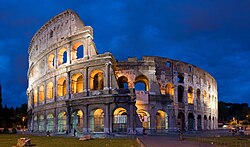Colosseum
The "Scots" that wis uised in this airticle wis written bi a body that haesna a guid grip on the leid. Please mak this airticle mair better gin ye can. (Dizember 2020) |
| Colosseum | |
|---|---|
 | |
| Location | Regio IV Templum Pacis ("Temple o Peace") |
| Biggit in | 70–80 AD |
| Biggit bi/for | Vespasian, Titus |
| Type o structur | Amphitheatre |
| Relatit | Leet o auncient monuments in Roum |
The Colosseum or Coliseum, kent as the Flavian Amphitheatre (Laitin: Amphitheatrum Flavium; Italian: Anfiteatro Flavio [aŋfiteˈaːtro ˈflaːvjo] or Colosseo [kolosˈsɛːo]) an aw, is an oval amphitheatre in the centre o the ceety o Roum, Italy. Biggit o travertine, tuff, an brick-faced concrete,[1] it is the lairgest amphitheatre iver biggit. The Colosseum is situatit juist east o the Roman Forum. Construction begoud unner the emperor Vespasian in AD 72,[2] an wis completit in AD 80 unner his successor an heir Titus.[3] Forder modifications war made in the ring o Domitian (81–96).[4] Thir three emperors are kent as the Flavian dynasty, an the amphitheatre wis named in Laitin for its association wi thair faimily name (Flavius).
The Colosseum coud hauld, it is estimatit, atween 50,000 an 80,000 spectators,[5][6] haein an average audience o some 65,000;[7][8] it is uised for gladiatorial contests an public spectacles sic as mock sea battles (for anerly a short time as the hypogeum wis suin filled in wi mechanisms tae support the ither activities), ainimal hunts, executions, re-enactments o famous battles, an dramas based on Clessical meethologie. The biggin ceased tae be uised for entertainment in the early medieval era. It wis later reuised for sic purposes as hoosin, wirkshops, quarters for a releegious order, a fortress, a quarrel, an a Christian shrine.
Awtho pairtially ruined acause o damage caused bi yirdquauks an stane-rabbers, the Colosseum is still an iconic seembol o Imperial Roum an is leetit as ane o the New7Wonders o the Warld.[9] It is ane o Roum's maist popular tourist attractions an forby haes airtins tae the Roman Catholic Kirk, as ilk Guid Friday the Pape leads a torchlit "Wey o the Cross" procession that stairts in the aurie aroond the Colosseum.[10]
References[eedit | eedit soorce]
- ↑ "Building the Colosseum". roman-colosseum.info. Archived frae the original on 27 December 2012. Retrieved 10 November 2018.
- ↑ Hopkins, p. 2
- ↑ "BBC's History of the Colosseum p. 2". Bbc.co.uk. 22 Mairch 2011. Retrieved 16 Apryle 2012.
- ↑ Roth, Leland M. (1993). Understanding Architecture: Its Elements, History and Meaning (First ed.). Boulder, CO: Westview Press. ISBN 0-06-430158-3.
- ↑ William H. Byrnes IV (Spring 2005) "Ancient Roman Munificence: The Development of the Practice and Law of Charity". Rutgers Law Review vol. 57, issue 3, pp. 1043–1110.
- ↑ "BBC's History of the Colosseum p. 1". Bbc.co.uk. 22 Mairch 2011. Retrieved 16 Apryle 2012.
- ↑ Baldwin, Eleonora (2012). Rome day by day. Hoboken: John Wiley & Sons Inc. p. 26. ISBN 9781118166291.
- ↑ Dark Tourism - Italy's Creepiest Attractions, The Local
- ↑ "The New Seven Wonders of the World". Hindustan Times. Julie 8, 2007. Archived frae the original on September 30, 2007. Retrieved Julie 11, 2007. Unknown parameter
|deadurl=ignored (help) - ↑ "Frommer's Events – Event Guide: Good Friday Procession in Rome (Palatine Hill, Italy)". Frommer's. Archived frae the original on 7 Januar 2009. Retrieved 8 Apryle 2008. Unknown parameter
|deadurl=ignored (help)
| This Italy-relatit airticle is a stub. Ye can help Wikipaedia bi expandin it. |
- 1st-century airchitectur
- Amphitheatres in Roum
- Auncient Roman airchitectur
- Biggin projects o the Flavian dynasty
- Roman airchaeology
- Ruins in Italy
- Naitional museums o Italy
- Roond biggins
- Roman amphitheatres in Italy
- 80s establishments in Italy
- 80s establishments in the Roman Empire
- Rome R. XIX Celio
- Titus
- Vespasian
- 80
- 80 in Europe
- Biggins an structurs completit in the 1st century
- Warld Heritage Steids in Italy
- Warld Heritage Steids in Europe
- Warld Heritage Steids
- Italy stubs

